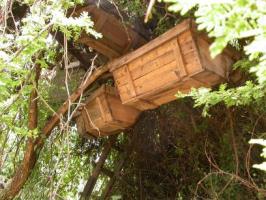24 November 2014
The Jackson Beehive was developed by the beekeeping Jackson family of Africa to cope with the tropical, humid conditions found in Southern Africa as well as the unique threats posed by Africa’s rather formidable animals and insects seeking the hive’s honey.
The Jackson hive is most similar to a top-bar hive. The hive is composed of a large oblong box. Instead of bars, the drawers with frames slide up and down vertically from the top of the box. Jackson hives became known for their size. The volume of the hive allowed larger frames with more than twice as many frames per hive as the standard Langstroth beehive.
Later versions of the Jackson emphasized size but, in the process, lost one of this hive’s most unique characteristics. Early Jackson’s were designed to be hung – suspended above the ground from a large tree branch or supporting beams
The idea for a hanging hive didn’t originate with the Jackson family. The large insects and fierce animals of Southern Africa could make beekeeping almost impossible. Hives would be raided, destroyed and the bees killed for their honey. Desperate beekeepers had resorted to hanging hives by narrow lines high from trees to preserve the hive, colony, and honey from predation.
The Jackson hive was the first hive designed to be hung rather than supported from the ground below. This was, in its time, a major innovation and a feature that made beekeeping in Southern Africa more productive.


